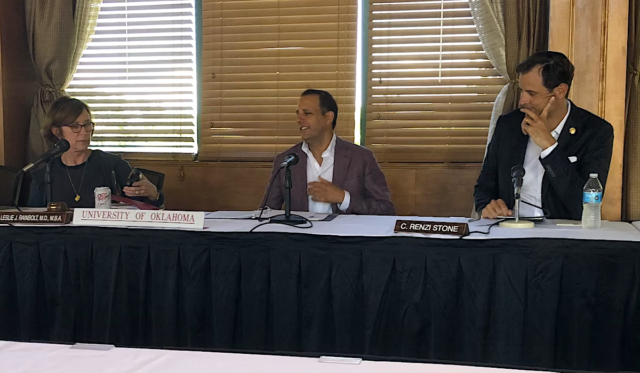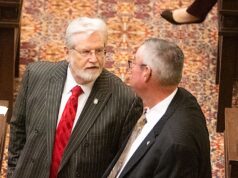
SULPHUR — In his first meeting as University of Oklahoma president, Joe Harroz praised the Oklahoma Legislature’s appropriation increase for higher education and presented the OU Board of Regents with a budget that “eliminates a structural operating deficit,” offers a faculty and staff pay raise and holds mandatory tuition and fees level for the second straight year.
“This is a budget that balances, this is a budget that makes an investment in our mission, and it is a point from which we can launch further,” Harroz said at the Chickasaw Retreat and Conference Center on Tuesday evening.
The OU Board of Regents also approved level tuition and fees at Cameron University, which it also oversees. Rogers State University’s tuition would increase by 3.8 percent. The tuition and pay raise moves will need to be approved by the State Regents for Higher Education on Thursday.
“Our goal is not just to have a sound budget,” Harroz told the board. “Our goal is to drive that mission we have that is sacred.”
OU tuition, fees rose dramatically over past two decades
For the academic year that just ended, OU’s mandatory tuition and fees totaled $11,762.50 for in-state students and $27,143.50 for out-of-state students.
According to data compiled by the Chronicle of Higher Education, in-state tuition and fees were just under $2,500 while out-of-state tuition and fees were just above $6,500. From 2001 through 2017, OU’s in-state tuition and fees increased at least 4.6 percent 15 out of those 17 years. From 2003 through 2008, those increases were at least 10 percent in each year except 2005.
“Look at what divides opportunity in society,” Harroz said after Tuesday’s meeting. “Usually what makes the difference is education. So if an education is inaccessible, if it’s only available based on your economic circumstance, then I don’t know how you can be a great university.”
In an attempt to encourage students to finish their degrees more quickly, OU implemented a “flat” tuition model for 2013-2014, meaning students taking 12 hours of course credit in a semester would pay the same amount as those taking 18.
Communications senior Tommy Pollard said earlier Tuesday that he has benefited from that change, taking up to 21 hours in a semester during his two years at OU.
“Out of state tuition is killer,” Pollard said. “Either way you’re either going to be stressed, or you’re going to have to (take out more loans).”
After working 40 hours per week to pay his way through a junior college, Pollard has taken out loans while at OU.
“I’m going to be very fortunate to come out of school with less than $20,000 (in loans) for two years at OU from out of state,” Pollard said. “I think lower tuition is always better for everyone.”
Ballet performance senior Kara Bannister agreed.
“I have taken out loans every year,” Bannister said. “I think I’ve done the math, and as of right now I’m $24,000 in debt.”
Bannister and Pollard both said they have also received scholarships to support their educations, but they still needed to take out loans. They said they appreciate the OU Board of Regents’ decision to avoid increasing tuition and fees for the second straight year.
“It’s always a big topic of conversation around campus or just my peers,” Bannister said. “I would like [the regents] to know that I am pleased if they do hold it down. That’s a little piece of mind going into my senior year not having to worry about another tuition raise.”
Pollard agreed.
“OU for out of state is just so expensive that you have to take out loans unless you have a family that has wealth or generational wealth,” he said.
Bannister, who works as a waitress on Campus Corner in Norman, called last year’s decision to keep tuition and fees level “a huge blessing.”
“I’m in the ballet world, so just the job field there is a risk. It’s nerve-racking going to be in debt and not knowing if I’m going to be in a job with steady income,” she said. “Scholarships get cut, and you’re constantly losing money, so if it was a steady rate and you knew what you were paying each year, I’d like to thank them for that.”
Harroz said OU will not always be able to hold tuition and fees level.
“Look at the history of tuition increases that have taken place,” Harroz said. “To hold it steady for two years says something in symbol and in substance. I think in symbol what it says is we understand what it means to be a great university — (where access) is based on merit and not based on just your economic circumstance.
“In substance, the reality is that the cost of an education is a real burden, and it has to be worth it.”
Faculty and staff salary increases
Harroz said at Tuesday’s meeting that staff at OU’s Norman and Health Sciences Center campuses would see a pay raise starting in the fall. He said “in the aggregate” the raises would be 3 percent. Faculty will see raises between 2 and 3 percent as well.
“Because of the Legislature and the partnership that has taken place, there will be an additional pool of money that equals 2.2 percent for a raise pool,” Harroz said.
After the meeting, OU’s communications department released a detailed explanation of the raises, which said in part:
The recommended OU FY20 budget is $2.02 billion and includes $983 million for the Norman campus and $1.04 billion for the HSC campus. The budget is designed to balance resource constraints with short- and long-term needs. The new budget includes a recommendation for a 3% salary program on average for eligible Norman staff, as well as compensation for staff at the HSC. In addition to a 2.6% annualized faculty salary increase on the Norman campus from January 2019, it also incorporates support from the Legislature for an additional 2.2% annualized faculty salary increase on the Norman campus and an annualized increase at HSC. The most recent faculty salary increases were made possible in the last legislative session through increased higher education appropriations. Both are proposed for October. A recommendation to increase stipends for graduate students and a reduction of fees for research-oriented graduate programs reflects OU’s continued emphasis on growing its research activity to support Oklahoma’s economy. OU Human Resources is determining the timeline and guidelines for instigating the process.
The OU Board of Regents is set to conduct committee work Wednesday and another public meeting Thursday during their annual retreat this week.
(Correction: This story was updated at 6:31 p.m. Tuesday, June 25, to provide more accurate details about the faculty and staff raises. It was updated again at 8 p.m. to correct reference to Rogers State University’s tuition.)





















